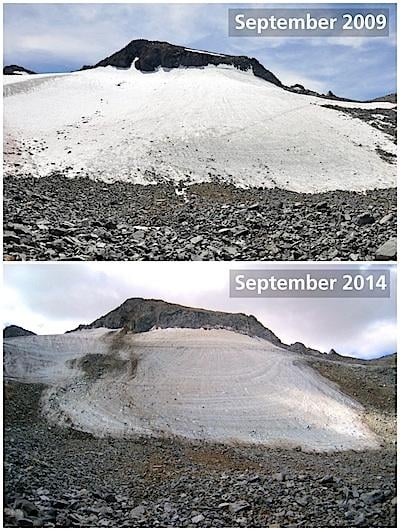
The shrinking Lyell Glacier/NPS photos.
Is it time to start a pool over when the Lyell Glacier in Yosemite National Park is no longer classified as a glacier? Or when it vanishes from the landscape? Those are good questions to ask, as the glacier, the second largest in the Sierra Nevada according to the National Park Service, is continuing to shrink.
The National Park Service's Climate Change Response team says the glacier "has thinned rapidly over just the last few years. Note (in the accompanying photo) the newly exposed bedrock on the east (left) side; it's estimated the glacier may now be only 15-20 feet thick. Currently the glacier is losing on average about three feet of thickness each year. How much longer until it's gone?"
It was back in February 2013 when word came that the Lyell Glacier had stagnated, or ceased its downhill movement, while the adjacent Maclure Glacier was still moving at its historical rate, about one inch per day.

 Support Essential Coverage of Essential Places
Support Essential Coverage of Essential Places







Comments
That makes sense to me. Remember - correlation does not equal causation. In fact, there are studies that suggest that CO2 (concentration) rises historically have trailed rather than led temperature rises.
OK Gary - provide us your sources that say global temperatures have risen over the last two decades. I am sure the IPCC and NOAA would be very interested. Its their agenda and they don't even claim that.
Really? Got any other rhetoric that needs a little debunking?
I honestly feel like i'm playing in that reality tv show "are you smarter than a 1st grader?".
Your evidence that global temperatures have risen over the last two decades is that 2013 tied for 7th for the highest temperature? LOL
I thought your Lyell glarcier claims were funny. This is just hilarious.
No, 2013 was tied for the 4th warmest year on record. It's pretty evident, that you have the reading comprehension capabilities of a 1st grader.
Download high resolution versions.
10 Warmest Years on Record Globally
It’s official: 2013 is tied with 2003 as the fourth warmest year for Planet Earth since modern record-keeping began more than 130 years ago. The mean global temperature rose 1.12°F above the 20th century average. That means the 10 warmest years on record have all happened since 1998, with 2010 still on top as the warmest of all. The only year in the entire 20th century that was warmer than 2013, and the only one remaining in the top 10, was 1998. This also marks the 37th straight year where the global temperature was above the long term average.
From your link:
NASA scientists say 2013 tied with 2009 and 2006 for the seventh warmest year since 1880
Who is comprehending at a 1st grade level? You can't even comprehend your own links. And seventh or third, it still doesn't dispute the glaring evidence that the trend in global temperature has been flat over the last 18 years.
PLAIN ENGLISH!
With the exception of 1998, the 10 warmest years in the 134-year record all have occurred since 2000, with 2010 and 2005 ranking as the warmest years on record.
NASA's Goddard Institute for Space Studies (GISS) in New York, which analyzes global surface temperatures on an ongoing basis, released an updated report Tuesday on temperatures around the globe in 2013. The comparison shows how Earth continues to experience temperatures warmer than those measured several decades ago. (WOULDN'T THAT BE EVIDENCE THAT TEMPERATURES ARE NOT FLAT, BUT WARMING, EC?...DUH. Reading comprehsion!!!!)
The average temperature in 2013 was 58.3 degrees Fahrenheit (14.6 degrees Celsius), which is 1.1 °F (0.6 °C) warmer than the mid-20th century baseline. The average global temperature has risen about 1.4 °F (0.8 °C) since 1880, according to the new analysis. Exact rankings for individual years are sensitive to data inputs and analysis methods.
You're wasting your time and effort, Gary.
God herself could lay the word on some folks and they'd still argue. Shades of Noah!
ec, how long can you tread water?